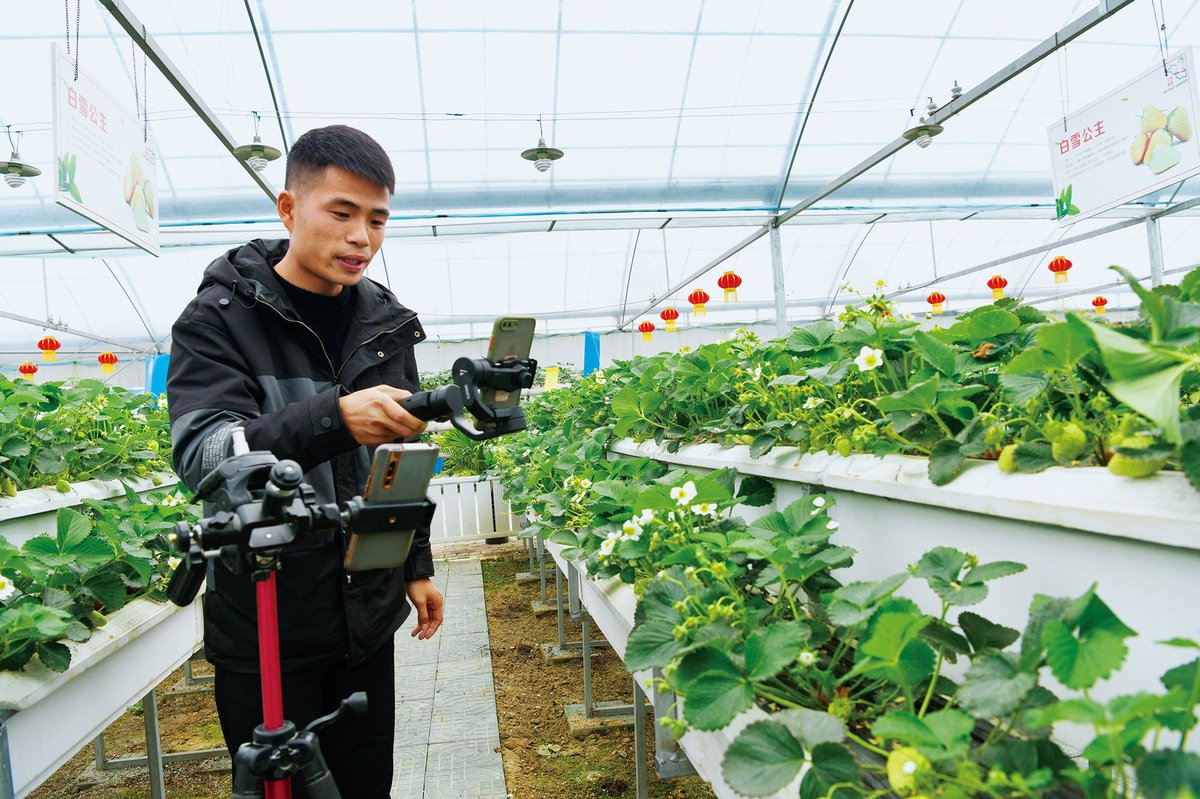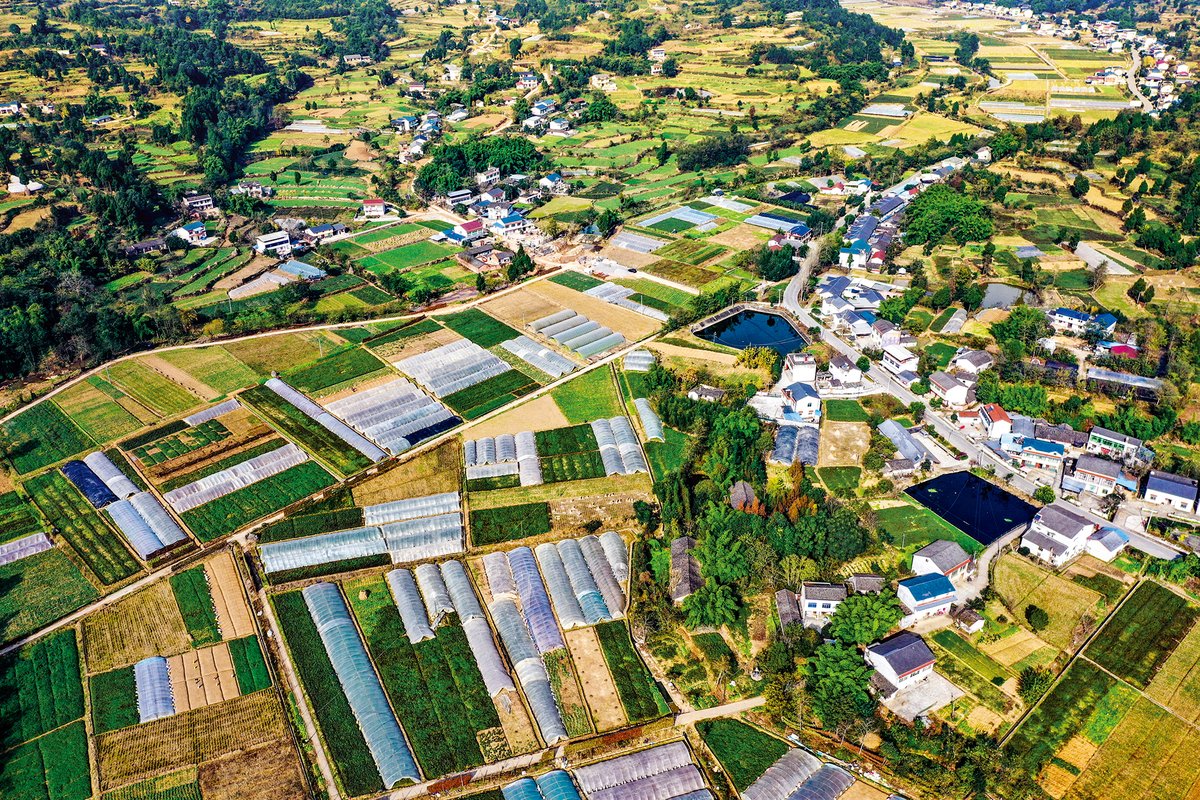Can “digital villages” fulfill their promise to modernize the countryside through technology?
In the spartan surroundings of his office, Zhao Lin surveys the village streets on a giant computer screen. On this “magic mirror” are images beamed to him from over 200 CCTV cameras, some with infrared capabilities, via the village’s speedy fiber-optic broadband network, which can alert Zhao to potential traffic accidents, crime, and natural disasters, as well as the growth of crops and prevalence of pests in the fields.
“Every year before, there were thefts and fights between villagers, but through the construction of this network, we were able to reduce the incidence of these crimes,” Zhao, the deputy Party secretary of Shuangshi village, located in Sichuan province, boasts to TWOC. And when he’s not observing the screen, the 34-year-old browses a smartphone app where villagers can record their concerns using wireless internet from one of the area’s seven 5G base stations. “We want to build an interactive bridge between the village committee and the villagers,” he says.
Zhao believes digital technologies like the “Magic Mirror Smart Eyes” hold the key to securing a prosperous future for villages. So does China’s central government: Since 2019, when the State Council issued the “Digital Village Development Strategy Outline,” it has promoted the development of “digital villages” throughout the country. The plan is for rural areas to have fast internet, 5G coverage, telemedicine facilities, high-tech agriculture run on big data, e-commerce, and “smart” finance, government, elderly care, and tourism that run on the latest digital innovations, so that urban and rural residents can enjoy equal access to public services.
But even with vast investment in digital infrastructure in places like Shuangshi, massive hurdles remain before China’s villages are dragged into a modern digital future. Though internet coverage now reaches even some of the remotest parts of the country, many villagers still struggle to use and understand online services, especially the elderly who make up nearly 25 percent of rural residents. Promises of booming sales in e-commerce and vast returns from “Taobao Villages” have failed to materialize in much of the countryside.
Meanwhile, technology for public security and surveillance is sometimes prioritized over improvements that might bring other benefits to villagers. In Shuangshi, the village committee is first focusing on “public governance” (it took eight months to install all the cameras needed for the Magic Mirror) before moving onto “smart agriculture,” according to Zhao.
Nonetheless, digital access is expanding rapidly in rural areas. By the end of 2020, for example, over 98 percent of villages in China had 4G network coverage, while internet penetration to rural areas rose from around 34 percent in 2017, to 57.6 percent in 2021. Online retail sales in rural areas reached 2.05 trillion yuan last year, up from just 180 billion yuan in 2014, according to statistics from the Ministry of Commerce and the state-affiliated China Internet Network Information Center (CNNIC).
Zhao’s village has seen rapid digitization over the last two years. “The village was the first in Sichuan to achieve full 5G coverage, and then full fiber-optic [broadband] coverage,” he claims. He’s also got big plans to connect the village via the Internet of Things (IoT) with “remote weather sensors, water quality sensors, soil sensors, and pest sensors” all transmitting data seamlessly to the village committee “so that we can understand the environmental situation of the village.”
But most villages remain far from the digital rural utopia envisaged in government plans. “The smartphone penetration rate in rural villages is high; this is not a problem,” says Gu Yizhen, associate professor of economics at Peking University’s HSBC Business School, “but how to use it...[especially] for old people: that’s a problem.” He cites as an example his father, who does not know how to use WeChat or Alipay, and “probably won’t feel comfortable paying for something first before getting the products.”
Xiao Wei, an agricultural researcher at Southwest University of Science and Technology, tells TWOC that digital agriculture technologies are too expensive for most farmers. Hi-tech, hi-definition cameras and monitoring devices could, in theory, be “available to every village…[but] if you don’t have the large scale to support this kind of platform, then it’s not very meaningful,” says Xiao. “If you’re just a small-scale farm…there’s no point” since farmers can monitor small plots themselves without spending on technology. Digital farming technologies, therefore, are mainly reserved for big agriculture companies and local governments.
In Shuangshi, the elderly “don’t understand or embrace this [digital technology]...because they have low exposure,” Zhao admits. “Some of them don’t even have smartphones.” In response, Zhao and his colleagues have established a “comprehensive service station” in the village where local officials and volunteers are on hand to help seniors use digital technologies for errands such as applying for their pensions online.
This year, Zhao explains, new rules require elderly pensioners to prove they are still alive, by uploading photos and videos of themselves to an app, in order to continue receiving their benefits. Many seniors in the village struggle with this process, or simply don’t have a smartphone, so head to the service station where they can receive help from officials.
Digitizing villages is also costly. Anding village in Zhejiang province has spent over 1 million yuan to turn itself into a “social media check-in spot” and was selected as one of the pilot areas for the province’s first batch of “future villages,” according to Farmers’ Daily. The village opened a campsite in May this year and invested in a WeChat mini-program which tourists can access via QR codes around the village to check how busy the site is, whether there are parking spaces available, see hiking routes, and buy local tea products. However, as Covid-19 restrictions and regular outbreaks across the country disrupt travel and tourism, it’s unclear how sustainable this model will prove to be.
Zhao tells TWOC that the added costs of all the digital projects in Shuangshi village so far, including the Magic Mirror system, come to more than 2 million yuan. Since the annual budget for the village committee is just 110,000 yuan, nearly all this funding has come from technology firms, mostly China Telecom, a giant state-owned telecommunications company. “The [government’s] ‘revitalization of the countryside’ plan is shifting the attention of the whole of society to the countryside...so big companies like China Telecom have plans to push their business and technology into rural areas,” says Zhao, explaining the company’s eagerness to fund rural projects.
Zhao calls Shuangshi village an “experimentation lab” in which some technologies and projects will inevitably fail, but he hopes some will become sustainable long term. The village’s next digital project is to develop “smart fishing,” deploying sensors in farmers’ ponds to measure and adjust water temperature, and pH and oxygen levels.
The sensors connect to smartphones, and Zhao hopes to help farmers avoid losses from fish dying in the summer due to low oxygen levels in water, a common phenomenon in the village which can cause “tens of thousands of yuan in damage overnight.” Normally, farmers must observe the fish to check for signs of danger, but “human experience is not accurate enough, and at night everyone has to sleep,” says Zhao, explaining the benefits of the digital system.
The system will cost around 10,000 yuan for farmers to install, plus a monthly service fee—a significant outlay for fish farmers who make around 60,000 to 80,000 yuan profit a year on a typical one mu (0.16 acre) pond. Farmers are enthusiastic to at least see the technology in action, according to Zhao, and over time he hopes the cost will come down as more people take it up and find it leads to higher profits.
“The farmers in the countryside are middle-aged or older; between 40 and 70 years old...so they are not so enthusiastic to embrace digital technology,” Zhao admits. “But they aren’t averse to it, as long as it can bring them some economic value [and] bring them some benefits, then they are willing to use it.”
For larger farms, technology can be helpful, argues Xiao. “The software can send data on pests directly to them, and automatically tell them what the pest is, how many there are, and how long they’ve been there.” Then the farm management or village committee can decide how to deal with it. At the national level, such systems can help government bureaus to monitor disease and pest outbreaks among crops and notify farms on the ground to take precautions, Xiao explains.
Besides agriculture, some villages have invested heavily in promoting e-commerce to put more money into residents’ pockets. But while online retail has boomed overall, some rural areas are seeing gains reversed. In a research paper published in 2021, Gu Yizhen and colleagues found that projects to connect rural areas to e-commerce failed to help villagers sell their products, nor did they have any significant impact on average incomes in the 100 villages they studied in Anhui, Henan, and Guizhou provinces.
E-commerce in villages risks becoming a race to the bottom as platforms encourage more villagers to sell, leading to competition between neighbors who try everything to cut costs and must spend on ads to compete. Gu argues “logistics cost is the major barrier to adopting e-commerce in villages,” citing lack of postal services and high transportation costs in rural areas. Furthermore, “on Taobao, only [products on] the first or second page can attract the attention from consumers…so you cannot expect every village to sell all its own products online.”
Not all villages are suited to becoming so-called “Taobao Villages” (defined by Alibaba as villages with at least 10 million yuan e-commerce sales annually and at least 100 online shops on Taobao run by local residents). In Guizhou province, for example, 13.73 million yuan of funding allocated to e-commerce projects for 106 villages remained unused in 2018 due to a lack of practical projects and insufficient e-commerce skills among residents, according to a paper by researchers from Australian National University published in 2021.
Despite all the investment and improvement in digital technologies in rural areas, there is still a vast gap to cities. In 2021, the rural internet penetration rate was 57.6 percent, compared to 81.3 percent in urban areas, according to the CNNIC. When schools closed during the pandemic, rural students suffered disproportionately because many of them struggled to participate in online classes due to poor internet coverage or phone reception.
In Shuangshi, however, Zhao believes the future is bright. “Let’s think about smartphones, right? Twenty years ago, it would hardly have been possible for everyone to have a smartphone…So new products like this are very expensive to develop in the early stages,” he says, drawing an analogy to the new digital technologies he is trying to promote in his village. “We hope that one day in the near future, these digital village solutions, like our smartphones today, can be used by everyone…every village, to help community governance and services, and agricultural development.”
Data Farming: How Digitalization is Changing China’s Villages is a story from our issue, “The Data Age.” To read the entire issue, become a subscriber and receive the full magazine.














